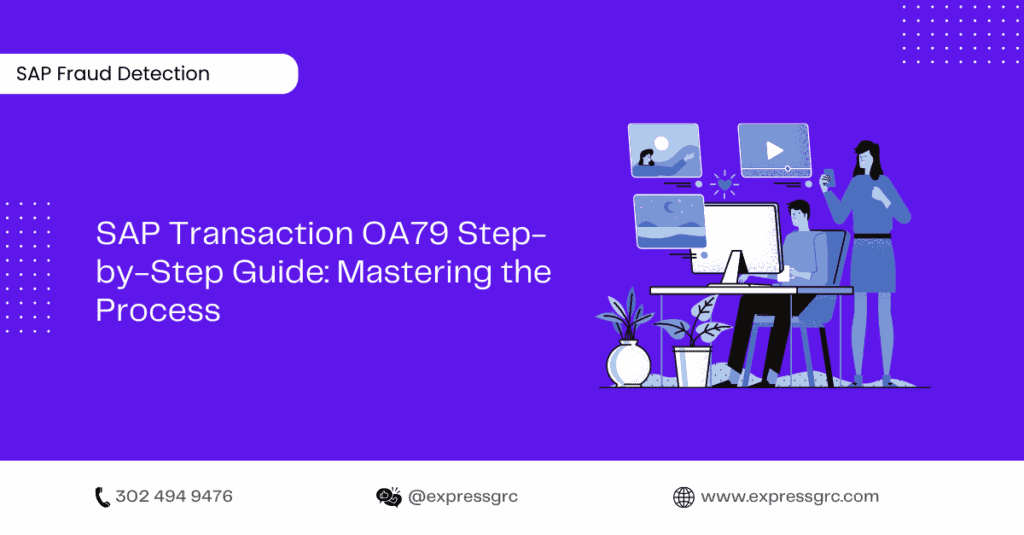Introduction
Welcome to our comprehensive guide on conducting risk assessment in SAP Fraud Management using the OA79 transaction. In today’s digital world, fraud has become a significant concern for organizations. It can result in financial losses, reputational damage, and loss of trust from customers and stakeholders. SAP Fraud Management is a powerful tool that can help your organization detect and prevent fraudulent activities.
In this article, we will walk you through the process of conducting risk assessment in SAP Fraud Management step-by-step. We’ll use a conversational tone, simple language, and real-world examples to make this guide accessible to everyone, regardless of their technical expertise. So, let’s dive in!

Table of Contents
| Sr# | Headings |
|---|---|
| 1. | Understanding SAP Fraud Management |
| 2. | Importance of Risk Assessment |
| 3. | Getting Started with SAP Transaction OA79 |
| 4. | Navigating the OA79 Transaction |
| 5. | Analyzing Existing Fraud Risks |
| 6. | Assessing Potential Fraud Scenarios |
| 7. | Setting Risk Levels |
| 8. | Mitigation Strategies |
| 9. | Implementing Fraud Prevention Measures |
| 10. | Monitoring and Reviewing |
| 11. | Continuous Improvement |
1. Understanding SAP Fraud Management
SAP Fraud Management is a sophisticated solution designed to detect and prevent fraud in various business processes. It provides a holistic view of potential fraud risks across different organizational units. By leveraging advanced analytics and machine learning algorithms, it can identify suspicious activities and patterns that may indicate fraudulent behavior.
2. Importance of Risk Assessment
Risk assessment is a crucial step in the SAP Fraud Management process. It helps you understand the specific vulnerabilities within your organization and allows you to prioritize fraud prevention efforts. By conducting a risk assessment, you can allocate resources effectively and focus on high-risk areas, ensuring a robust fraud management strategy.
3. Getting Started with SAP Transaction OA79
To initiate the risk assessment process, you’ll be using the SAP Transaction OA79. This transaction provides a user-friendly interface to manage fraud risks efficiently. It allows you to create, modify, and analyze fraud detection scenarios, making it an essential tool for risk assessment.
4. Navigating the OA79 Transaction
Once you access the OA79 transaction, you’ll find a well-organized dashboard with various options and functionalities. The main sections include:
- Scenarios Overview: Provides an overview of existing fraud detection scenarios.
- Risk Assessment: Allows you to assess and prioritize fraud risks.
- Simulation: Enables you to simulate potential fraud scenarios and evaluate their impact.
- Mitigation: Suggests mitigation strategies to reduce fraud risks.
- Monitoring and Reporting: Helps you monitor fraud prevention measures and generate reports.
5. Analyzing Existing Fraud Risks
Before creating new fraud detection scenarios, it’s essential to analyze the existing ones. The OA79 transaction allows you to review previously implemented scenarios and their effectiveness. By understanding historical data, you can fine-tune your fraud management strategy and improve detection accuracy.
6. Assessing Potential Fraud Scenarios
In this step, you’ll be creating new fraud detection scenarios based on your organization’s unique requirements. You can define various conditions, rules, and thresholds to trigger fraud alerts. The OA79 transaction provides a user-friendly interface, making it easy to configure scenarios without extensive technical knowledge.
7. Setting Risk Levels
Once you’ve established fraud detection scenarios, it’s time to set risk levels. Each scenario can have different risk levels, indicating the severity of potential fraud. By assigning risk levels, you prioritize alerts and ensure that high-risk incidents receive immediate attention.
8. Mitigation Strategies
SAP Fraud Management not only identifies potential fraud but also offers mitigation strategies. When a suspicious activity is detected, the system can suggest appropriate actions to prevent or minimize the impact of fraud. These suggestions can be based on historical data and best practices, empowering your organization to respond effectively.
9. Implementing Fraud Prevention Measures
With your fraud detection scenarios and risk levels in place, it’s time to implement fraud prevention measures. This involves integrating SAP Fraud Management with your existing business processes and systems. By doing so, you can automatically trigger fraud alerts and take immediate action when necessary.
10. Monitoring and Reviewing
Fraud prevention is an ongoing process. It’s crucial to monitor the effectiveness of your fraud management strategy continuously. Regularly reviewing fraud detection scenarios, risk levels, and mitigation strategies ensures that your organization stays ahead of emerging fraud risks.
11. Continuous Improvement
Fraudsters are constantly evolving, so your fraud management approach must do the same. Embrace a culture of continuous improvement, where feedback from fraud incidents and detection accuracy drives enhancements to your fraud prevention measures.
Conclusion
In conclusion, conducting risk assessment in SAP Fraud Management using the OA79 transaction is a fundamental step in protecting your organization from fraud. By understanding your vulnerabilities, implementing effective detection scenarios, and continuously improving your fraud prevention measures, you can safeguard your business’s financial health and reputation.
Remember, fraud prevention is a team effort that requires collaboration from various stakeholders within your organization. Stay vigilant, and use SAP Fraud Management as a powerful tool to fight against fraudulent activities.
FAQs
Q1. What is SAP Fraud Management? A1. SAP Fraud Management is a powerful solution designed to detect and prevent fraud in business processes, helping organizations protect themselves from financial losses and reputational damage.
Q2. How does risk assessment benefit my organization? A2. Risk assessment helps identify vulnerabilities, prioritize fraud prevention efforts, and allocate resources effectively, ensuring a strong fraud management strategy.
Q3. Is SAP Transaction OA79 user-friendly? A3. Yes, the OA79 transaction provides a user-friendly interface, making it accessible to users with varying levels of technical expertise.
Q4. Can SAP Fraud Management suggest mitigation strategies? A4. Yes, the system can suggest appropriate mitigation strategies based on historical data and best practices to respond effectively to potential fraud.
Q5. Why is continuous improvement important in fraud prevention? A5. Fraudsters are constantly evolving their tactics, so continuous improvement allows your organization to adapt and stay ahead of emerging fraud risks.
Remember, mastering risk assessment in SAP Fraud Management is an ongoing journey. Stay proactive, be informed, and leverage the power of technology to protect your organization from fraud threats effectively.
